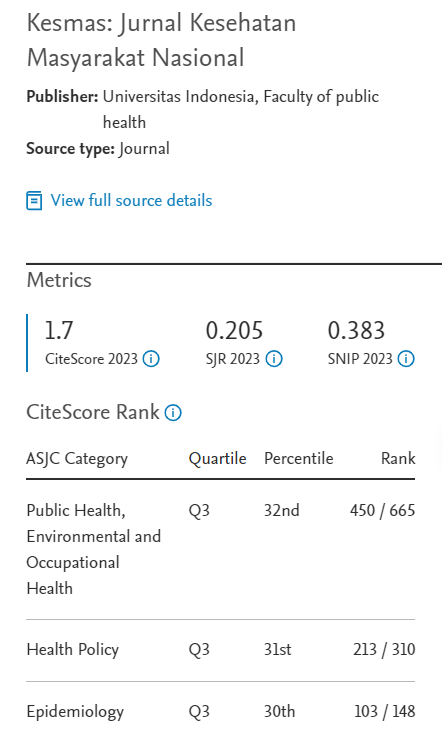Abstract
Berdasarkan data Kementerian Sosial, jumlah usia lanjut (usila) di Indonesia tahun 2004 tercatat 16.522.311 jiwa dan 3.092.910 jiwa atau sekitar 20% adalah usila terlantar. Nutrisi yang kurang pada usila berdampak pada kesehatan sehingga relatif mudah terjangkit penyakit infeksi dan gangguan zat gizi. Selain itu, asupan makanan berhubungan dengan depresi, jumlah gigi, gangguan gigi, penggunaan obat, penyakit, dukungan sosial seperti kunjungan keluarga atau orang terdekat, dan rasa makanan. Tujuan penelitian ini adalah mengetahui berbagai faktor yang berhubungan dengan asupan makanan pada usila. Penelitian menggunakan desain studi cross sectional dilakukan terhadap 58 orang usila di Panti Sosial Tresna Werdha Budi Mulia 01 Cipayung pada periode bulan Mei-Juni tahun 2010. Metode analisis multivariat digunakan untuk melihat faktor dominan yang berpengaruh terhadap asupan makanan. Sekitar 62,1% usila di panti sosial yang diteliti mempunyai asupan makanan yang kurang. Berdasarkan hasil analisis multivariat, makanan, penyakit, dan jumlah gigi merupakan faktor yang paling dominan memengaruhi asupan makanan pada usila.
Ministry of Sosial Welfare, the number of elder in Indonesia 2004 was recorded 16.522.311 and 3.092.910 or about 20% were neglected elders. Poor nutrition will impact on the health of the elders that directly related the infectious disease and the level of food intake. Besides, food intake is also associated with depression, the number of theet, the dental disorders, drug use, diseases, social support include the visit of the family or the people around them, and the taste of the food. The objective of study is to describe the factors that associated with food intake on the elders. This study that was conducted in Mei-June 2010 used cross sectional design. The sample that was suitable with criteria used in this study is about 58 people. The study used multivariate analysis to know the dominant factors that affected food intake. The result showed that 62,1% of elders in Panti Sosial Tresna Werdha Budi Mulia 01 Cipayung has less food intake. Based on the results, the diseases, depression, number of the teeth, and taste of the food are associated with food intake of the elders.
References
- Maryam S, dkk. Usia lanjut dan perawatannya. Jakarta: Salemba Medika; 2008.
- Nisa H. Faktor-faktor determinan status gizi lansia penghuni panti werdha pemerintah DKI Jakarta tahun 2004. Media Penelitian dan Pengembangan Kesehatan Litbangkes (MPPK). 2006; XVI (3): 24-34.
- Grosvenor, Smolin. Nutrition from science to life. Philadelpia: Hill Companies; 2002.
- Sumiyati N. Hubungan antara tingkat konsumsi energi dan protein dengan status gizi pada lansia di panti werdha Pucang Gading Semarang. 2007 [diakses tanggal 31 Januari 2010]. Diunduh dari: http://www.digilib.unnes.ac.id.
- Schiffman SS, Warwick ZS. Effect of flavor-enhancement of foods for the elderly on nutritional status: food intake, biochemical indices, and anthropometric measures. Physiology and Behavior. 1993; 63: 395-402.
- Tambunan V. Gizi pada usia lanjut. 2009 [diakses tanggal 27 februari 2010]. Diunduh dari: http://www.repository.ui.ac.id.
- Darmodjo B. Geriatri (ilmu kesehatan usia lanjut). Edisi keempat. Jakarta: Balai Penerbit Fakultas Kedokteran Universitas Indonesia; 2009.
- Jain, Phadnis. Effect of physiogical problems on dietary intake of elderly. Indian Journal of Gerontology. 2007; 21 (1): 44-51.
- Syamsudin. Depresi pada lansia. 2006 [diakses tanggal 16 Juni 2009]. Diunduh dari: http://www.depsos.go.id.
- Husaini. Penelitian keadaan gizi dan faktor-faktor biomedika terhadap makanan sosiokultural dan psikologi yang mempengaruhi lanjut usia dalam laporan penelitian Bogor. Bogor: Kementerian Kesehatan Republik Indonesia; 1990.
- Sullivan DH. Oral health problems and involuntary weight loss in a population of elderly. Journal of the American Geriatries Society. 1993; 41: 725-31.
- Sheiham A, Stelee J. Does the condition of the mouth and teeth affect the ability to eat certain foods, nutrient, dietary intake, and nutritional status among older people? Public Health Nutritiont. 2001; 4(3): 797- 803 [diakses tanggal 8 Juni 2010]. Diunduh dari: http://www.journals.cambridge.org.
- Locher JL, Ritchie CS, Roth DL, Sen B, Vickers KS, Vailas LI. Food choice among homebound older adults: motivations and perceived barries. J Nutr Health Aging. 2009; 13 (8): 659-64 [diakses tanggal 17 Juni 2010]. Available from: http://www.ncbi.nlm.nih. gov.
- Jubhari, Eri H. Proses menua sendi temporomandibula pada pemakai gigi tiruan lengkap. Cermin Dunia Kedokteran. 2002; 137: 41-5.
- Morley J. Symposium on ‘nutrition and the elderly’ protein-energy malnutrition in older subjects. 1998 [diakses tanggal 6 Juni 2010]. Diunduh dari: http://www.journal.cambridge.org.
- Nugroho W. Keperawatan gerontik. Edisi 2. Jakarta: EGC; 2000.
Recommended Citation
Amran Y , Kusumawardani R , Supriyatiningsih N ,
et al.
Determinan Asupan Makanan Usia Lanjut.
Kesmas.
2012;
6(6):
255-260
DOI: 10.21109/kesmas.v6i6.78
Available at:
https://scholarhub.ui.ac.id/kesmas/vol6/iss6/3







